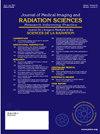适用于不同 CT 机系统的新型无幻影定量计算机断层扫描:骨密度质量保证评估
IF 1.3
Q3 RADIOLOGY, NUCLEAR MEDICINE & MEDICAL IMAGING
Journal of Medical Imaging and Radiation Sciences
Pub Date : 2024-10-01
DOI:10.1016/j.jmir.2024.101518
引用次数: 0
摘要
背景/目的质量保证(QA)研究是骨密度测量(BMD)的一项重要研究。特别是对于定量计算机断层扫描(QCT)而言,由于 QCT 骨密度测量通常在不同的 CT 机上进行,因此这种研究在临床上并不实用。这项质量保证研究旨在评估质量参数,包括在不同 CT 机上使用新型无模型 QCT(PL-QCT)测量 vBMD 的准确度和精确度。本研究使用欧洲脊柱模型(ESP)作为测量参考。每台 CT 机都独立扫描 ESP 10 次,并在 120kV 电压下重新定位。随机选取同一天在同一台 CT 机上以 120kV 扫描的 10 名患者的 CT 数据进行 PL-QCT BMD 校准。PL-QCT 软件采用自动算法在软组织(肌肉和脂肪)上放置校准感兴趣区 (ROI)。结果在所有 CT 机中,与 ESP 参考值相比,十次重复 ESP L1-3 vBMD 测量的平均值不超过 ±5mg/cm3。只有一台 CT 机的 L3 段未达到 ±5mg/cm3 的阈值。对每台 CT 扫描仪的三个 vBMD 测量值进行线性回归,得出 SEE 的中位数为 1.44 mg/cm3,范围在 1.37 至 2.28 mg/cm3 之间。所有 CT 扫描仪测得的变异系数的平均值和范围约为 0.12% (0.11-0.14%)。这种新型 PL-QCT 是一种可靠、适用的骨质疏松症评估设备,结合其在回顾性筛查中的优势,它可能是一种值得推广的 QCT 技术。本文章由计算机程序翻译,如有差异,请以英文原文为准。
The novel phantom-less quantitative computed tomography for different CT machine systems: Bone mineral density quality assurance evaluation
Background/Purpose
Quality assurance (QA) study is a significant research for bone mineral densitometry (BMD). Especially for quantitative computed tomography (QCT), such study was clinical practical as QCT bone density measurements were generally executed on different CT machines. This QA study aimed to evaluate quality parameters includes accuracy and precision of vBMD measurements by a novel phantom-less QCT (PL-QCT) on different CT machines. European spine phantom (ESP) was used as measurement reference in this study.
Methods
10 CT machines and 100 patients were enrolled. For each CT machine, the ESP was scanned independently 10 times with repositioning under 120kV. CT data of 10 patients scanned on the same CT machine in the same day under 120kV were randomly selected for PL-QCT BMD calibration. An automatic algorithm was used for calibration region of interest (ROI) placement on soft tissues (muscle and fat) in PL-QCT software. ESP reference values by manufacturer were used as standard for BMD measurements evaluation.
Results
For all CT machines, the average of ten repeated ESP L1-3 vBMD measurements did not exceed ±5mg/cm3 in comparison with ESP reference value. Only one CT machine failed to satisfy the ±5mg/cm3 threshold for L3 segment. The linear regression of the three vBMD measurements for each CT scanner yielded a median SEE of 1.44 mg/cm3, with a range from 1.37 to 2.28 mg/cm3. The mean and range of the coefficients of variation measured by all CT scanners was approximately 0.12% (0.11-0.14%).
Conclusions
The deviations of BMD results on different CT machines are within the acceptable range. This novel PL-QCT was a reliable and applicable osteoporosis evaluation device, combining its benefits on retrospective screening, it could be a QCT technique worth promoting.
求助全文
通过发布文献求助,成功后即可免费获取论文全文。
去求助
来源期刊

Journal of Medical Imaging and Radiation Sciences
RADIOLOGY, NUCLEAR MEDICINE & MEDICAL IMAGING-
CiteScore
2.30
自引率
11.10%
发文量
231
审稿时长
53 days
期刊介绍:
Journal of Medical Imaging and Radiation Sciences is the official peer-reviewed journal of the Canadian Association of Medical Radiation Technologists. This journal is published four times a year and is circulated to approximately 11,000 medical radiation technologists, libraries and radiology departments throughout Canada, the United States and overseas. The Journal publishes articles on recent research, new technology and techniques, professional practices, technologists viewpoints as well as relevant book reviews.
 求助内容:
求助内容: 应助结果提醒方式:
应助结果提醒方式:


